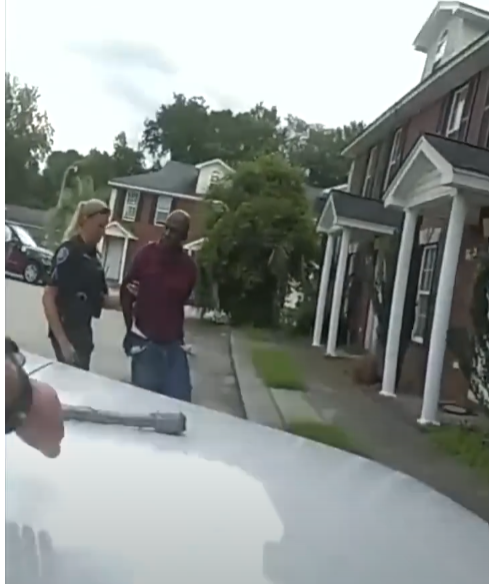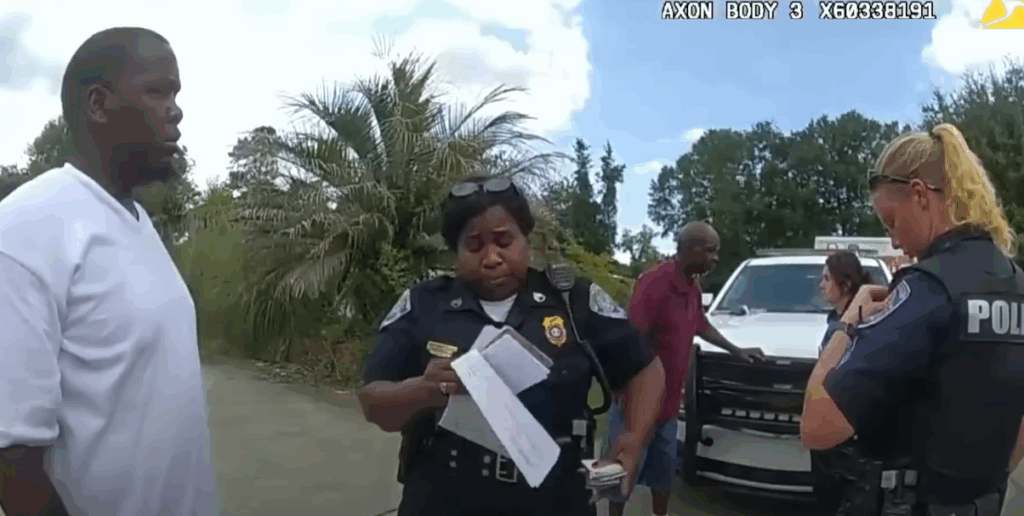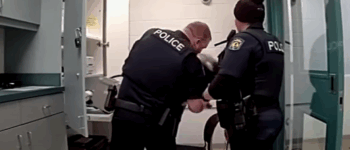What unfolded on an otherwise ordinary day in Orangeburg, South Carolina, was not simply a misunderstanding between a police officer and a citizen. It was a stark reminder of the dangers posed by unchecked authority, the culture of silence within law enforcement, and the devastating consequences for those who are falsely accused. At the center of this disturbing incident is Officer David Lance Dukes, whose violent actions against a disabled man, Clarence Gailyard, and the subsequent attempt to conceal those actions, reveal just how fragile accountability remains in American policing.
The Call That Sparked It All
The chain of events began with a 911 call. The caller, a relative of Clarence Gailyard, phoned police claiming he was armed and trying to break into homes. Dukes, responding to the call, arrived with his weapon already drawn, shouting conflicting commands.
“Get on the ground! Get on the ground! Get on the ground!” Dukes barked repeatedly, his voice escalating in panic and aggression. His target: Gailyard, wearing a burgundy shirt, standing near a truck.
Gailyard, visibly struggling due to prior injuries from a severe car accident—metal pins and a surgical rod held his leg, knee, and hip together—attempted to comply. Yet his movements were slower, measured, and painfully deliberate. To Dukes, however, they were not fast enough.

A Disabled Man Treated as a Threat
Within seconds, the situation escalated beyond reason. Dukes accused Gailyard of concealing a firearm and, in a sudden act of violence, stomped on Gailyard’s head, forcing it into the hard pavement.
The force of the blow was captured on Dukes’ own body camera. Gailyard cried out:
“You bust my head down on the cement! I’m disability. I got head problems!”
Yet no gun was ever found. The alleged weapon was nothing more than a small makeshift baton wrapped in duct tape, a tool Gailyard carried to protect himself from stray dogs in the neighborhood. Even more damning: the original 911 caller later admitted she had never seen him with a firearm at all.
Despite this, Dukes clung to his version of events. “I thought it was a gun,” he told fellow officers. “He wasn’t listening.”
The Lies That Followed
Instead of admitting fault, Dukes spun a narrative designed to justify his excessive use of force. He told colleagues that Gailyard had moved suspiciously, that he had refused to comply, and that he had acted in a way that forced Dukes’ hand. But the footage—irrefutable, damning—told a different story.
It showed a man struggling to move quickly because of his disability, not because of defiance. It showed an officer more interested in exerting dominance than de-escalating a tense situation. It showed misconduct in its rawest form.
And perhaps most tellingly, it showed something else: the look on Sergeant Aquilla Poulidor’s face.
A Rare Stand Against Misconduct
Sergeant Poulidor, a veteran officer, witnessed the aftermath of Dukes’ actions and refused to play along with the cover-up. When Dukes attempted to minimize his misconduct, Poulidor stared him down, unflinching. She refused to falsify her report or bend the truth to shield him from accountability.
Her written report sharply criticized Dukes, not only for lying in his official documentation but also for disrespecting her when she refused to lie on his behalf. Poulidor then took steps to calm Gailyard, seek medical attention for him, and ensure his voice was heard.

Her actions stand as a rare but vital reminder that integrity within law enforcement still exists—though often at a professional cost.
Settlement Without True Justice
Gailyard later filed a civil lawsuit against the City of Orangeburg. He was awarded $650,000 in a settlement, but the payout came from the city’s insurance carrier, not from Dukes or the department itself. For Gailyard, the money provided some compensation but not justice. For Dukes, the consequences have been minimal at best.
The Orangeburg Department did fire Dukes immediately after the bodycam footage surfaced, a surprising move in a system where officers are often shielded from discipline. He was even charged with first-degree assault and battery, a serious offense.
Yet more than two years later, Dukes has faced no trial, no conviction, no prison time. He continues to live freely, walking the same streets where he once brutalized Gailyard.
A Symbol of a Larger Problem
This case is not just about one violent officer. It is a microcosm of a national crisis. Across the United States, victims of police violence are often left scarred physically and emotionally, while officers evade meaningful accountability. Settlements are paid out quietly by city insurance carriers or taxpayers, while the offending officers continue their lives largely unscathed.
Until systemic changes occur—such as requiring officers to be personally liable for civil judgments, creating independent oversight boards, and enforcing strict penalties for falsifying reports—stories like Clarence Gailyard’s will continue.
The Human Cost
For Gailyard, the scars are permanent. He carries not only the physical pain of being stomped into concrete but also the psychological trauma of knowing the system nearly failed him. His disability made him vulnerable; Dukes’ violence made him a victim.
For Sergeant Poulidor, the case stands as a moment of moral clarity. Her refusal to compromise her integrity, her willingness to call out misconduct in real time, provided a rare glimpse of hope. She showed that accountability is possible—but only if individuals are willing to take risks and break the so-called “blue wall of silence.”
For the public, the case is another chilling reminder of how fragile safety and justice can be when those sworn to protect abuse their power.
Conclusion
Officer Dukes’ brutality and dishonesty were laid bare, but justice remains elusive. Clarence Gailyard was left with a payout but no closure. Sergeant Poulidor emerged as an unlikely hero in a system designed to discourage dissent.
The case is still unresolved in the courts, but in the court of public opinion, the verdict is clear: Dukes’ actions were an abuse of power, and Poulidor’s stand was an act of courage.
Until law enforcement institutions are restructured to prioritize truth over loyalty, citizens over cover-ups, and accountability over excuses, the cycle will repeat. And for every Clarence Gailyard, there will be countless others whose names never make the headlines.


